

Kinesthetic Learning Strategies - Activities to Help Tactile Learners. Adult Education Centre - Adult Learning Styles. Exercise - Reflection on Learning Characteristics of Adult Learning Motivating Factors in Adult Learning Learning Styles Implications for Delivery Practical Classroom Tips Bibliography Glossary All adults come to courses with varied experiences and varied educational backgrounds.
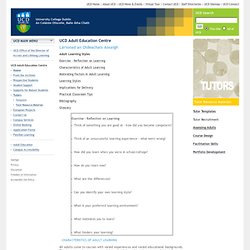
Adults have accumulated life experiences. Adults have a range of different motivations for selecting a course/programme: Learning styles vs teaching methods. Different Learning Styles in Education. Different people learn differently, and psychologists have attempted through the years to spell out the traits of different types of learners and categorize them into different “learning styles.”

Naturally, there are many models of different learning styles in education. The most widely used is the VAK learning styles model, developed in 1987 by Neil Fleming, a high school and university teacher from New Zealand. Its letters stand for the three learning styles: visual, auditory, and kinesthetic. Fleming later added a fourth, read/write, changing the acronym to VARK.
As a teacher, your best option is to use a variety of teaching techniques to give all students the best chance to succeed. 6 different types of ESL learners and how to teach them. Adapt your lessons to cater for the different learning styles of your students When we are teaching English to kids, as teachers we need to be aware of the differences in learning styles of our students so that we can incorporate all of these learning styles into our lessons.
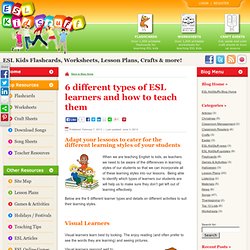
What is Visual Learning – The Visual Learning Style – Visual Learning Traits. Are you one of those people who closes your eyes to envision the exact location of where you left your car keys?
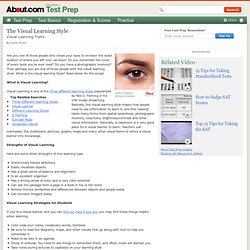
Do you remember the cover of every book you've ever read? Do you have a photographic memory? Education.vermont.gov/documents/educ_accommodations_strategies.pdf. Helping Visual Learners Succeed. We all want our children to do well in school.

Sometimes though kids struggle with their school work and we’re just not sure how to help. As a school counselor, the first thing I do to help students academically is to identify how they learn. There are three different ways we learn. We either learn by seeing (visual), hearing (auditory), or doing (kinesthetic). Visual Learners - Learning Styles and Visual Learners. A Look at Visual Learners: A typical visual learner uses visualization techniques to remember things.
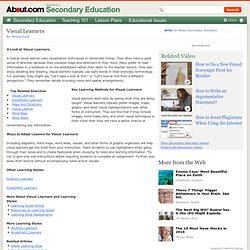
They often have a good sense of direction because they visualize maps and directions in their mind. Many prefer to read information in a textbook or on the whiteboard rather than listen to the teacher lecture. They also enjoy doodling and drawing. Pearson Prentice Hall: eTeach: Strategies for Visual Learners. By Patricia Vakos Introduction: Contrasting Styles From Personal Experiences Challenges of the Visual Learner Strategies for Teaching Visual Learners Implications for the Teacher Bibliography Links Silent and very still sat 18 kindergarten students, patiently waiting for the teacher to begin her lesson.
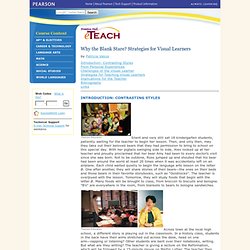
Then, and only then, may they take out their beloved bears that they had permission to bring to school on this special day. With her pigtails swinging side to side, Alex looked up at her teacher and proudly proclaimed that her bear Amy had been to every doctor's visit since she was born. Not to be outdone, Ross jumped up and shouted that his bear had been around the world at least 20 times when it was accidentally left on an airplane. Across town at the local high school, a different story is playing out in the classroom. Then there is John, who is dying to leave class.
What is Auditory Learning? Learning Styles. What Is My Learning Style - Auditory Learner. The Definition of the Visual Learning Style. The visual (spatial) learning style. If you use the visual style, you prefer using images, pictures, colors, and maps to organize information and communicate with others.

You can easily visualize objects, plans and outcomes in your mind's eye. You also have a good spatial sense, which gives you a good sense of direction. You can easily find your way around using maps, and you rarely get lost. When you walk out of an elevator, you instinctively know which way to turn. The whiteboard is a best friend (or would be if you had access to one). Common pursuits and phrases Some pursuits that make the most use of the visual style are visual art, architecture, photography, video or film, design, planning (especially strategic), and navigation. Visual, Auditory and Kinesthetic (VAK) learning style model. A common and widely-used model of learning style is Fleming’s (2001) Visual Auditory Kinesthetic (VAK) model.
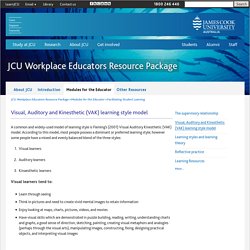
According to this model, most people possess a dominant or preferred learning style; however some people have a mixed and evenly balanced blend of the three styles: Visual learnersAuditory learnersKinaesthetic learners Visual learners tend to: Learn through seeingThink in pictures and need to create vivid mental images to retain informationEnjoy looking at maps, charts, pictures, videos, and moviesHave visual skills which are demonstrated in puzzle building, reading, writing, understanding charts and graphs, a good sense of direction, sketching, painting, creating visual metaphors and analogies (perhaps through the visual arts), manipulating images, constructing, fixing, designing practical objects, and interpreting visual images. 3 Learning Styles. Everyone processes and learns new information in different ways.
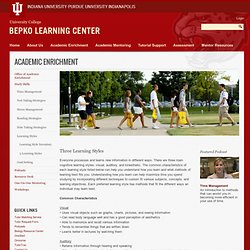
There are three main cognitive learning styles: visual, auditory, and kinesthetic. The common characteristics of each learning style listed below can help you understand how you learn and what methods of learning best fits you. Understanding how you learn can help maximize time you spend studying by incorporating different techniques to custom fit various subjects, concepts, and learning objectives.
Each preferred learning style has methods that fit the different ways an individual may learn best. Formative Assessment Strategies. The Value of Formative Assessment. The current wave of test-based "accountability" makes it seem as though all assessment could be reduced to "tough tests" attached to high stakes. The assumption, fundamentally unproven, is that such tests produce real improvements in student learning better than do other educational methods.
In this environment, Paul Black and Dylan Wiliam's "Inside the Black Box: Raising Standards Through Classroom Assessment" (Phi Delta Kappan, October 1998) provides strong evidence from an extensive literature review to show that classroom "formative" assessment, properly implemented, is a powerful means to improve student learning -- but summative assessments such as standardized exams can have a harmful effect.
Summative assessment is the attempt to summarize student learning at some point in time, say the end of a course. Most standardized tests are summative. They are not designed to provide the immediate, contextualized feedback useful for helping teacher and student during the learning process. Edisdat.ied.edu.hk/pubarch/b15907314/full_paper/1926551038.pdf. Web.uvic.ca/~gtreloar/Assessment/Periodical Items/Working Inside the Black Box-Assessment for Learning in the Classroom.pdf. September 2012. Formative vs. Summative Assessment: Does It Matter? By Deena Boraie Assessment terminology has become a minefield because it often obscures distinctions between concepts, which in turn affects classroom practice. Examples of Formative Assessment.
When incorporated into classroom practice, the formative assessment process provides information needed to adjust teaching and learning while they are still happening. The process serves as practice for the student and a check for understanding during the learning process. The formative assessment process guides teachers in making decisions about future instruction. Here are a few examples that may be used in the classroom during the formative assessment process to collect evidence of student learning. Observations Questioning Discussion. Assessment for learning: are you using it effectively in your classroom? Engagement and effort are essential characteristics of good learners. Research indicates that children who start school socially and academically ahead of their peers tend to be more successful in school.
This results in an achievement gap, which widens as children move through the school system if it persists. One of the factors that can influence this is the way assessment is perceived by youngsters who start at a disadvantage; it can either strengthen or break their belief in their capabilities. Schools in England have become data driven; teachers are heavily influenced by the need to produce summative performance data to assess school effectiveness, set targets and monitor standards.
Most schools have amalgamated this into their regular monitoring systems with teachers being asked to report on achievement every few months. Summative Assessment Definition. Summative assessments are used to evaluate student learning, skill acquisition, and academic achievement at the conclusion of a defined instructional period—typically at the end of a project, unit, course, semester, program, or school year.
Generally speaking, summative assessments are defined by three major criteria: The tests, assignments, or projects are used to determine whether students have learned what they were expected to learn. Definition of Formative Assessment. Definition: A formative assessment can be defined as a variety of mini assessments that allow a teacher to adjust instruction on a frequent basis. Definition of Summative Assessment. Types of Summative Assessment. 'Summative' assessments are set to enable tutors to evaluate, and assign a mark to their students' learning at a particular point in time.
The mark assigned contributes to the final outcome of the students' degree. The most important thing when completing any form of assessment or examination is to establish what the goalposts are, by looking at: the exact details of the assignment, including instructions about format, presentation and structure the marking criteria for the assessment the "intended learning outcomes" for the course, i.e. what the tutor has stated that s/he expects you to be able to demonstrate in order to pass the course These should be made available in handbooks, via Blackboard and/or on course unit outlines distributed by the course unit leader.
Inclusive assessment approaches to learning in the English Language Classroom – I’m a teacher not a psychologist! 'I think there is a learner in my class with SEN but I’m not sure, because I don’t know what I should be looking for and I don’t know what to do next. I probably should talk to the parent but don’t know how.’Eliza, primary teacher from Italy 'We have to do state exams at the end of the year and I know some of the learners with SENs in my class won’t be at the right standard. Assessment for learning: are you using it effectively in your classroom? Formative%20and_summative_assessment. Formative Assessment. Formative vs Summative Assessment - Teaching Excellence & Educational Innovation - Carnegie Mellon University.